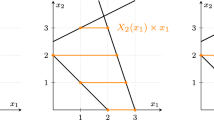Abstract
In this paper, we extend the notion of diagonally strictly concave functions and use it to provide a sufficient condition for uniqueness of Nash equilibrium in some concave games. We then provide an alternative proof of the existence and uniqueness of Nash equilibrium for a network resource allocation game arising from the so-called Kelly mechanism by verifying the new sufficient condition. We then establish that the equilibrium resulting from the differential pricing in the Kelly mechanism is related to a normalised Nash equilibrium of a game with coupled strategy space.
Similar content being viewed by others
References
P. J. Kolodzy, Interference temperature: A metric for dynamic spectrum utilization, International Journal of Network Management, 16(2) (2006), 103–113.
F. P. Kelly, Charging and rate control for elastic traffic, European Transactions on Telecommunications, 8 (1997), 33–37.
B. Hajek and G. Gopalakrishnan, Do greedy autonomous systems make for a sensible Internet? Presented at the Conference on Stochastic Networks, Stanford University, CA, 2002.
R. Johari and J. N. Tsitsiklis, Efficiency loss in a network resource allocation game, Mathematics of Operations Research, 29(3) (2004), 407–435.
R. Johari, S. Mannor and J. N. Tsitsiklis, Efficiency loss in a network resource allocation game: The case of elastic supply, IEEE Transactions on Automatic Control, 50(11) (2005), 1712–1724.
R. Johari and J. N. Tsitsiklis, Efficiency of scalar-parameterized mechanisms, Operations Research, 57(4) (2009), 823–839.
R. Ma, D. M. Chiu, J. Lui, V. Mishra and D. Rubenstein, Price differentiation in the Kelly mechanism, in Workshop on Pricing and Incentives in Networks, W-PIN, London, UK, June 2012.
J. Rosen, Existence and uniqueness of equilibrium points for concave n-person games, Econometrica, 33(3) (1965), 520–534.
A. Orda, N. Rom and N. Shimkin, Competitive routing in multi-user communication networks, IEEE/ACM Transaction on Networking, 1(5) (1993), 614–627.
N. Shimkin, A survey of uniqueness results for selfish routing, in Proceedings of NETCOOP 2007, LNCS 4465, (2007), 33–42.
L. S. Shapley, A solution containing an arbitrary closed component, Contribution to the theory of games, 4 (1959), 87–93.
D. Monderer and L. S. Shapley, Potential games, Games and Economic Behavior, 14 (1996), 124–143.
D. M. Topkis, Equilibrium points in nonzero-sum-person submodular games, SIAM Journal on Control Optimization, 17 (1979), 773–778.
R. D. Yates, A framework for uplink power control in cellular radio systems, IEEE Journal on Selected Areas in Communications, 13 (1995), 1341–1347.
C. U. Saraydar, N. B. Mandayam and D. J. Goodman, Efficient power control via pricing in wireless data networks, IEEE Transactions on Communications, 50(2) (2002), 291–303.
A. A. Kulkarni and U. V. Shanbhag, On the variational equilibrium as a refinement of the generalized Nash equilibrium, Automatica, 48 (2012), 45–55.
E. Altman and E. Solan, Constrained games: The impact of the attitude to adversary’s constraints, IEEE Transactions on Automatic Control, 54(10) (2009), 2435–2440.
W. Leininer and C. Yang, Dynamic rent seeking games, Games and Economic Behavior, 7 (1994), 406–427.
O. Richman and N. Shimkin, Topological uniqueness of the Nash equilibrium for selfish routing, Mathematics of Operations Research INFORMS, 32(1) (2007), 215–232.
Author information
Authors and Affiliations
Corresponding author
Additional information
Eitan Altman and Rajesh Sundaresan were supported by IFCAM (Indo-French Centre for Applied Mathematics). Manjesh Kumar Hanawal was supported by the European Commission within the framework of the CONGAS project FP7-ICT-2011-8-317672.
Rights and permissions
About this article
Cite this article
Altman, E., Hanawal, M.K. & Sundaresan, R. Generalising diagonal strict concavity property for uniqueness of Nash equilibrium. Indian J Pure Appl Math 47, 213–228 (2016). https://doi.org/10.1007/s13226-016-0185-4
Received:
Accepted:
Published:
Issue Date:
DOI: https://doi.org/10.1007/s13226-016-0185-4




